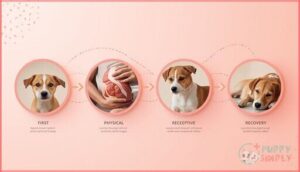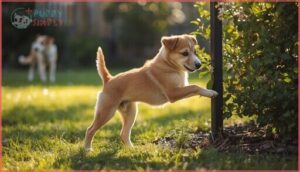This site is supported by our readers. We may earn a commission, at no cost to you, if you purchase through links.
Your dog’s first heat cycle won’t necessarily be shorter than her subsequent ones, though it may appear that way. The average first heat lasts between two to four weeks, comparable to later cycles, but many owners miss the early signs entirely—a phenomenon veterinarians call a “silent heat.”
Subtle swelling, minimal discharge, or behavioral changes that haven’t yet become obvious can make the first cycle seem briefer or even undetectable. Understanding what you’re actually looking for, from physical symptoms to behavioral shifts, helps you recognize when your dog enters this reproductive phase.
Proper identification matters for her health, your planning around spaying decisions, and preventing accidental breeding during her fertile window.
Table Of Contents
- Key Takeaways
- What is a Dog’s First Heat Cycle?
- Stages of The First Heat Cycle
- Is a Dog’s First Heat Shorter?
- Why First Heats May Appear Shorter
- Factors Affecting First Heat Duration
- Signs Your Dog is in Her First Heat
- Caring for a Dog in Her First Heat
- Veterinary Guidance for First Heat
- Preventing Unwanted Pregnancy in First Heat
- When to Expect The Next Heat Cycle
- Frequently Asked Questions (FAQs)
- How often do female dogs come into heat?
- Do male dogs have heat cycles?
- Is there any way to prevent a female dog’s heat cycle?
- Can stress delay a dogs first heat cycle?
- Do mixed breeds have different heat patterns?
- Are there medications to postpone first heat?
- Can diet affect first heat cycle timing?
- Do littermates experience heat cycles simultaneously?
- Conclusion
Key Takeaways
- A dog’s first heat cycle typically lasts two to four weeks—comparable to later cycles—but often appears shorter because owners miss early signs like subtle vulvar swelling, minimal discharge, or “silent heats” where ovulation occurs without visible symptoms.
- Breed size significantly affects first heat timing: toy and small breeds cycle between 4-7 months, medium breeds around 7-9 months, large breeds at 12-16 months, and giant breeds may wait 18-24 months before reaching sexual maturity.
- Dogs can become pregnant during their first heat cycle despite physical immaturity, making strict supervision, secure containment, and separation from intact males critical to prevent accidental breeding and associated health risks.
- Spaying before the first heat cycle reduces mammary tumor risk by up to 90 percent, while waiting until after multiple cycles provides substantially less protection, making early veterinary consultation about timing essential for long-term health outcomes.
What is a Dog’s First Heat Cycle?
A dog’s first heat cycle, also known as the initial estrus period, represents the beginning of sexual maturity and fertility in female dogs. The timing of this biological marker varies considerably depending on breed size, with smaller breeds usually experiencing their first heat earlier than their larger counterparts.
Understanding what happens during this cycle is essential for responsible ownership, allowing you to provide appropriate care, prevent unwanted pregnancies, and make informed decisions about your dog’s reproductive health.
Definition of First Heat
Your dog’s first heat cycle marks her entry into puberty—the initial estrus cycle when reproductive hormones surge and fertility begins. This inaugural heat introduces characteristic symptoms: vulvar swelling, blood-tinged discharge, and behavioral shifts as her body reacts to hormone changes.
Unlike later cycles, a dog’s first heat can present subtly, making it easy to overlook early reproductive health milestones in canine estrus. Understanding canine heat cycles is vital for identifying these changes.
Typical Age of Onset by Breed
Breed size factors shape when your female dog will enter her first heat cycle. Toy and small breeds often reach canine puberty earliest—between 4 and 7 months—while medium dogs usually cycle around 7 to 9 months. Large breeds may not show heat cycle variations until 12 to 16 months, and giant breeds can wait 18 to 24 months before reproductive maturity, reflecting breed specific timing tied to growth rate.
Understanding the dog heat cycle is vital for dog owners to provide proper care.
Importance for Dog Owners
Knowing when your dog’s first heat begins carries real weight for her long-term health. This baseline also guides spaying decisions, prevents accidental pregnancy, and helps you manage marking, restlessness, and hygiene through each canine estrus cycle stage—all essential owner responsibilities for female dog health.
You’ll need to track discharge, behavior shifts, and timing to catch irregularities that signal pyometra or other reproductive disease early.
Stages of The First Heat Cycle
Your dog’s first heat cycle unfolds in four distinct stages, each marked by specific hormonal shifts and physical changes. Understanding these phases helps you recognize what’s happening at each point and respond appropriately to your dog’s needs.
The stages progress in a predictable sequence, though the intensity and visibility of signs can vary between individual dogs.
Understanding how big your husky will eventually get can help you anticipate which developmental signs to watch for at each stage.
Proestrus Phase Characteristics
Proestrus marks the opening chapter of your dog’s heat cycle, usually lasting 7–9 days but sometimes stretching to three weeks. You’ll notice vulvar swelling and bloody discharge—signs driven by surging estrogen levels that trigger pheromone production.
Many owners choose to spay their Australian Shepherd before the first heat cycle to avoid dealing with these hormonal changes altogether.
Male dogs will suddenly show intense interest, yet your female won’t permit mating. She’ll tease, play, then firmly refuse advances, keeping her tail tucked protectively over her vulva throughout this preparatory phase.
Estrus Phase and Fertility
Receptivity defines the estrus phase, when your dog’s hormone balance shifts from peak estrogen to rising progesterone. This fertile phase usually spans 5–9 days, though some bitches extend beyond two weeks.
For breed-specific insights—like understanding how long Huskies reproduce and their unique cycle patterns—you can better prepare for your dog’s individual needs.
Her discharge lightens to straw-colored, and she’ll ‘flag’ her tail aside, inviting mating. Fertility tests measuring progesterone guide ideal breeding windows, as ovulation occurs roughly two days post-LH surge during this critical canine estrus interval.
Breeders often wait until a beagle’s second or third cycle to avoid the complications of breeding during the first heat, allowing for healthier litters and safer pregnancies.
Diestrus and Anestrus Overview
After your dog stops accepting mates, diestrus begins—the luteal phase lasting roughly 60 days regardless of pregnancy. Progesterone levels peak around two weeks post-ovulation, driving uterine changes and preparing her body for potential implantation.
Hormone regulation then shifts into anestrus, a four-month resting phase with minimal ovarian activity. Together, these canine estrus cycle stages complete her reproductive health timeline between heats.
Is a Dog’s First Heat Shorter?
The question of whether a dog’s first heat is shorter than subsequent cycles generates considerable interest among dog owners, yet the answer isn’t as straightforward as you might expect.
Clinical evidence and veterinary observations reveal a nuanced picture that often differs from popular assumptions.
Let’s examine what research shows, what experts report, and what pet owners commonly observe in their own dogs’ first heat experiences.
Average Length of First Heat Vs. Later Cycles
Many owners wonder if their dog’s first heat follows the usual pattern. Generally, the initial heat cycle runs about the same length as later cycles—roughly 2 to 3 weeks of visible heat symptoms. However, individual cycle variations exist:
- Hormone fluctuations may cause irregular heat length initially
- Heat symptoms can be subtler, affecting perception of duration
- Fertility windows usually establish predictable patterns after the first cycle
- Breeding timings become more consistent as the canine estrus cycle stages mature
Your dog’s estrus cycle should stabilize with subsequent heats.
Clinical Research and Expert Opinions
Veterinary insights reveal no strong evidence that first heats are uniformly shorter. Reproductive specialists emphasize that proestrus and estrus usually follow the same 2–3 week pattern across cycles, with individual cycle variations driven by breed, development, and hormonal maturity.
Research findings note that apparent brevity often stems from silent or split heats—common in young bitches—rather than truly abbreviated reproductive cycle phases, underscoring the importance of accurate canine reproductive health monitoring.
Common Observations Among Pet Owners
Owner experiences reveal that your dog’s first heat often feels fleeting compared to later cycles. Pet care strategies during this phase can mask the true canine reproductive health timeline, while subtle heat cycle variations lead many to underestimate duration:
- Light spotting for only 7–10 days instead of the expected 2–3 weeks
- Mild vulvar swelling easily missed during routine grooming
- Behavioral shifts—clinginess or restlessness—noticed before any bleeding
- Male dogs’ interest serving as the clearest signal, not discharge
- Split heats mistaken for two separate, shorter episodes
Canine behavior changes and owner education gaps contribute to this common perception of a brief first heat, even when the dog’s reproductive cycle follows the standard timeline.
Why First Heats May Appear Shorter
You might notice your dog’s first heat seems to pass more quickly than you expected, but the actual duration often falls within the normal range. The issue isn’t always that the cycle is genuinely shorter—it’s that certain factors can make it appear that way.
Several reasons explain why you may have missed the full extent of your dog’s first heat cycle.
Subtle or “silent” Heat Symptoms
Sometimes your dog goes through what’s known as a silent heat—an estrus cycle with minimal bleeding and barely noticeable vulvar swelling, even though ovulation and hormonal shifts proceed normally. You might miss external signs entirely, yet male dogs will still detect pheromone detection cues.
This hidden estrus is especially common during a dog’s first heat, making accurate canine reproductive health issues assessment challenging without veterinary testing like vaginal cytology or progesterone monitoring.
Missed Early Signs by Owners
Even when physical Silent Heat Symptoms appear, your inexperience might cause you to overlook them entirely. Proestrus bleeding can be so light that fastidious dogs lick it away, masking estrus cycle progression and diminishing Owner Awareness.
Behavioral Canine Behavior Changes—restlessness, clinginess, or mild irritability—often seem like nothing unusual. This combination of Subtle Signs and first-time unfamiliarity explains why many owners genuinely believe their dog’s first heat was unusually brief, when in reality they simply missed the early days.
Individual Dog Variations
Beyond owner oversight, real biological Genetic Factors drive variation in your dog’s first heat cycle duration. Some bitches inherit longer anestrus phases, delaying the next heat cycle and masking how long the first truly lasted. Hormonal Influences, Nutritional Impacts, and Environmental Effects further complicate timing:
- Breed Differences—small breeds cycle faster than large
- Underweight dogs show delayed estrus
- Stress disrupts reproductive hormones
- Thyroid issues prolong anestrus
- Silent heats occur without visible discharge
These factors explain why heat cycle duration varies wildly among individual dogs in heat.
Factors Affecting First Heat Duration
Not every dog’s first heat follows the same timeline, and several underlying factors can shift the duration you observe. Breed characteristics, developmental readiness, and overall health all play distinct roles in shaping how long this initial cycle lasts.
Understanding these influences helps you set realistic expectations and recognize what’s normal for your individual dog.
Breed and Size Influences
Breed variations and size factors create striking physiological differences in how your female dog experiences her heat cycles. Smaller breeds often reach sexual maturity earlier, between 4 and 7 months, while giant breeds may not cycle until 18 to 24 months. This genetic influence affects not just timing but also the duration and intensity of each heat cycle, impacting your overall dog heat cycle management approach.
| Size Category | First Heat Timing |
|---|---|
| Small/Toy | 4–7 months |
| Medium | 7–9 months |
| Large/Giant | 18–24 months |
Reproductive health in dogs varies considerably by breed type. Primitive breeds like Basenjis cycle only once yearly, while most companion breeds experience heat twice per year. Understanding these breed-specific patterns helps you anticipate your dog’s reproductive health needs and prepare for effective dog reproduction management throughout her life.
Age and Physical Development
Your female dog’s first heat usually arrives before she’s fully grown. Most dogs experience their initial canine heat while growth plates remain open, often between 6 and 9 months, but skeletal maturity doesn’t occur until 9 to 15 months depending on size. This timing creates important considerations:
- Estrogen drives growth plate closure during heat cycle
- Large breeds show greater gaps between first heat and physical maturation
- Hormone balance influences bone density accumulation
- Developmental stages continue well beyond initial estrus
- Growth patterns vary markedly by breed size
Understanding these developmental stages helps you make informed decisions about your dog in heat.
Health, Nutrition, and Environment
Nutrient balance directly affects hormone regulation in your female dog’s reproductive health. Deficiencies in protein, essential fatty acids, or zinc can delay or shorten the first heat cycle, while environmental toxins from pesticides or plastics may disrupt canine health issues. Regular health monitoring helps you identify dietary needs before they compromise your dog’s reproductive maturity.
| Factor | Impact on First Heat |
|---|---|
| Poor nutrition | Delayed onset, irregular bleeding patterns |
| Adequate protein intake | Facilitates normal hormone regulation |
| Environmental toxins | May disrupt heat cycle timing |
| Chronic health conditions | Can suppress or alter reproductive health |
Signs Your Dog is in Her First Heat
Recognizing your dog’s first heat requires careful attention to both physical and behavioral shifts that develop over several days. The signs can range from obvious anatomical changes to subtle alterations in how she interacts with her environment and other dogs.
Understanding these indicators will help you identify the onset of her cycle and respond with appropriate care measures.
Physical and Behavioral Changes
Your dog’s first heat cycle triggers a cascade of physical symptoms and behavioral shifts driven by hormone fluctuations during proestrus and estrus. Watch for these telltale signs:
- Restlessness, pacing, or difficulty settling, especially at night
- Increased affection-seeking or clinginess toward you
- Tail tucking early on, then “flagging” when receptive
- Mounting behavior directed at other dogs or objects
- Heightened interest from male dogs and potential escape attempts
These hormonal changes affect emotional changes and social interactions noticeably.
Vaginal Discharge and Swelling
Bloody discharge and vulvar swelling are usually your first reliable clues. During proestrus, you’ll notice bright to dark red discharge alongside pronounced vulvar enlargement—often three to four times normal size—as estrogen surges. As your dog transitions into estrus, the discharge lightens to pink or straw-colored and thins, while swelling softens but remains visible throughout her fertile window.
| Heat Stage | Discharge Color & Volume | Vulvar Swelling |
|---|---|---|
| Early Proestrus | Bright or dark red; heavy, serosanguinous | Rapid enlargement begins; firm, tense tissue |
| Late Proestrus | Red to pink; moderate volume | Maximum size reached; vulva prominent |
| Estrus (Fertile) | Pink, straw, or clear; decreasing | Softer texture; still visibly enlarged |
| Normal Throughout | No foul odor; no systemic illness | Symmetrical; no pain or ulceration |
| Abnormal Signs | Yellow, green, pus-like, or malodorous | Painful, ulcerated, or asymmetric swelling |
Check the vulva daily, documenting color, volume, and any changes in swelling stages. Gently clean the perivulvar area with damp cloths to maintain hygiene and prevent dried blood accumulation. If you see yellow or green discharge, severe swelling with pain, or systemic signs like fever or lethargy, contact your vet immediately—these infection signs warrant urgent evaluation, not routine vulvar care.
Marking and Mounting Behavior
Increased urine marking—small deposits in multiple spots both indoors and outdoors—signals reproductive readiness through hormone-laden scent cues that attract intact males.
You may also observe mounting behavior directed at other dogs, people, or soft objects, driven by sexual arousal and heightened reproductive hormones.
Both patterns intensify during estrus, forming a coordinated behavioral profile tied to your dog’s fertility window and breeding readiness.
Caring for a Dog in Her First Heat
Your dog’s first heat requires attentive care to keep her comfortable, safe, and healthy throughout the cycle. This period can feel overwhelming, but with the right approach to hygiene, behavior, and environment, you can help your dog navigate this natural process with minimal stress.
The following sections outline practical strategies for managing the three most critical aspects of first-heat care.
Maintaining Hygiene and Comfort
Keeping your dog clean during her heat cycle protects her from infection and discomfort. Change dog diapers or absorbent pads every 3-4 hours to prevent skin irritation and bacterial growth around the vulvar area. Gently wipe the vulvar region with warm water or pet-safe wipes to reduce discharge buildup.
Heat pads on low settings can ease muscular tension, while washable bedding rotated daily maintains sanitary conditions throughout bloody discharge phases.
Managing Behavioral Changes
Hormonal surges during the first heat cycle trigger noticeable shifts in your dog’s behavior, including restlessness, clinginess, and occasional irritability.
You’ll support her through these changes by limiting contact with intact males, providing puzzle toys for mental stimulation, and maintaining predictable daily routines. Synthetic dog appeasing pheromone diffusers reduce anxiety-driven pacing and whining, while gentle physical contact helps ease hormonally influenced distress without encouraging unwanted behaviors.
Exercise and Safe Environments
Beyond adjusting her daily routine, you’ll need to rethink outdoor activities during the heat cycle to prevent accidental breeding and keep your dog safe.
Leashed walking on secure routes protects her from intact males drawn to pheromonal cues, while proper leash handling and fencing prevent escapes:
- Choose early morning or late evening walks to avoid high dog traffic and reduce encounters with off-leash males
- Use securely fenced yards or private gardens for outdoor exercise, checking gates and fence lines for gaps
- Keep her on a short leash at all times outside the home, using a well-fitted collar to prevent slipping if she attempts to reach other dogs
Veterinary Guidance for First Heat
Your veterinarian acts as your most reliable resource during your dog’s first heat cycle, offering guidance customized to her specific needs and circumstances. Consulting a professional ensures you’re prepared to recognize potential complications, maintain your dog’s health, and make informed decisions about her reproductive future.
The following areas represent key veterinary considerations you’ll want to address during this developmental stage.
When to Consult a Vet
You should seek veterinary attention promptly if your dog shows signs of infection or distress during her first heat. Emergency care becomes critical when you notice cream-colored or bloody discharge accompanied by lethargy, vomiting above 104°F, or sudden collapse. Veterinary consultation ensures proper health monitoring throughout this vulnerable period.
| Symptom Category | Specific Signs | Action Required |
|---|---|---|
| Reproductive Infection | Foul-smelling discharge, excessive vulvar swelling, abdominal bloating | Immediate veterinary care |
| Systemic Illness | Anorexia, depression, persistent vomiting, increased thirst | Urgent veterinary attention |
| Heat-Related Emergency | Body temperature >104°F, red mucous membranes, difficulty breathing | Emergency veterinary medicine |
Monitoring for Health Issues
You’ll need to watch for abnormal vaginal discharge—especially foul-smelling, green, or yellow discharge—which signals uterine infections like pyometra.
Monitor your dog’s behavior for lethargy, vomiting, increased thirst, or fever in the weeks following her first heat. These systemic illness signs indicate serious reproductive health complications requiring immediate veterinary care.
Pyometra risks increase after each cycle, making careful observation of your dog’s health essential during this vulnerable period.
Discussing Spaying Options
Your vet can help you weigh spay benefits against surgical risks during your dog’s first heat consultation. Timing matters—veterinary guidance increasingly recommends spaying before the first estrus to reduce mammary tumor risk by up to 90 percent, though breed-specific considerations apply.
Vets increasingly recommend spaying before a dog’s first heat to slash mammary tumor risk by up to 90 percent, though breed matters
Key spaying discussion points:
- Neuter costs range from $50 to $2,000 depending on facility type and dog size
- Recovery tips include 10-14 days of activity restriction for traditional procedures
- Postoperative care requires monitoring incisions and managing pain appropriately
- Health outcomes eliminate pyometra risk entirely while extending longevity in many dogs
Laparoscopic techniques offer faster healing but cost more than traditional ovariohysterectomy.
Preventing Unwanted Pregnancy in First Heat
Your dog can become pregnant during her first heat cycle, even if she’s still young and growing. Male dogs can detect hormonal changes from significant distances, making accidental breeding a genuine concern without proper precautions.
Understanding the risks and implementing effective containment strategies will help you navigate this fertile period safely.
Risks of Accidental Breeding
Accidental breeding during your dog’s first heat cycle carries serious consequences you can’t afford to overlook. Health risks to both dam and puppies include pregnancy complications, birth defects, and higher neonatal mortality rates.
Beyond immediate health consequences, you’ll face substantial financial burdens—emergency C-sections alone cost $1,000-$5,000.
Unwanted litters also worsen pet overpopulation and shelter strain, contributing to millions of homeless animals annually.
Safe Containment and Supervision
During your dog’s heat cycle, secure fencing becomes your first line of defense against unwanted litters. You must inspect your yard for gaps, weak spots, or potential escape routes before her cycle begins.
Supervised walks on a sturdy leash and contained dog enclosures prevent heat behavior from leading to accidental breeding. Never leave your dog in heat outdoors unattended, even momentarily.
Use of Dog Diapers and Barriers
Diaper hygiene and barrier systems work together to manage your dog in heat while reducing accident prevention risks. Change diapers every three to four hours to prevent skin infections, and combine them with baby gates or closed doors when intact males are present.
- Moisture-wicking liners minimize wetness and odor from vaginal bleeding
- Physical barriers prevent penile penetration during mating attempts
- Supervised outdoor leash walks remain essential despite diaper use
- Regular diaper-free intervals promote canine safety and proper pet care
Remember, diapers offer a backup layer for heat management and dog health monitoring, not foolproof pregnancy prevention during the heat cycle.
When to Expect The Next Heat Cycle
After your dog’s first heat cycle completes, you’ll naturally wonder when the next one will arrive, how to track it, and whether you should plan for spaying or breeding. Most dogs cycle every six to eight months, though this interval can vary based on breed, size, and individual physiology.
Understanding these patterns helps you prepare appropriately and make informed decisions about your dog’s reproductive future.
Typical Intervals Between Cycles
Most intact females experience estrus roughly twice per year, placing the interval between heat cycles at approximately six to seven months. However, you’ll notice considerable variation depending on breed specifics and individual hormonal influences. Smaller dogs may cycle every four to six months, while giant breeds often space heats nine to twelve months apart. Pregnancy, age, and health all shape these reproductive health patterns, making each dog’s heat cycle timeline unique.
| Breed Size | Typical Interval | Cycles Per Year |
|---|---|---|
| Small breeds | 4–6 months | 2–3 heats |
| Medium/Large breeds | 6–7 months | ~2 heats |
| Giant breeds | 9–12 months | 1–2 heats |
Tracking and Predicting Future Heats
Maintaining a written log—or using a dedicated estrous tracking app—allows you to calculate your dog’s individual interestrus interval with far greater accuracy than relying on generic six-month estimates. Record the first day of vulvar swelling or discharge as day one, then note the full duration of visible signs.
Over successive heat cycles, these Canine Fertility records reveal your dog’s unique Heat Cycle Patterns, improving Cycle Prediction and enabling proactive heat cycle management for future Breeding Management decisions.
Planning for Spaying or Breeding
Once you’ve tracked your dog’s heat cycle patterns, you’ll need to decide: spaying or breeding? Spay timing matters—proceeding before the first heat nearly eliminates mammary tumor risk, whereas waiting until after 2.5 years offers less protection.
If breeding plans include your dog, ethical breeders postpone mating until at least the second cycle, ensuring physical maturity fosters healthy pregnancy and sound reproductive health throughout her fertile years.
Frequently Asked Questions (FAQs)
How often do female dogs come into heat?
Most healthy females cycle about twice yearly—roughly every six months. Though your dog’s reproductive rhythm depends on her size and breed, with intervals ranging from four months to over a year in some cases.
Do male dogs have heat cycles?
No, male dogs don’t experience heat cycles. Unlike females, males remain continuously fertile year-round once they reach sexual maturity, usually around six to twelve months of age, without cyclical reproductive phases.
Is there any way to prevent a female dog’s heat cycle?
Spaying before puberty reduces mammary tumor risk up to 200-fold. Surgical removal of the ovaries permanently prevents heat cycles and unwanted pregnancy, while hormone therapy offers temporary cycle management under veterinary supervision.
Can stress delay a dogs first heat cycle?
Yes, chronic stress can delay your dog’s first heat cycle by disrupting hormone balance and suppressing reproductive cycle activity. Environmental factors like poor nutrition, overcrowding, or frequent rehoming may postpone heat onset, affecting fertility timing.
Do mixed breeds have different heat patterns?
Mixed breed traits don’t create unique heat patterns—canine hormones follow the same four-stage cycle regardless of pedigree.
Heat variability in dogs stems from genetic factors like body size and individual physiology, not purebred versus mixed breed comparison.
Are there medications to postpone first heat?
Hormone therapy can postpone a dog’s first heat cycle, but medication risks are significant.
Proestrus delay options like megestrol acetate or deslorelin implants require strict veterinary guidance, as they carry health concerns that must be carefully weighed against temporary postponement methods.
Can diet affect first heat cycle timing?
Diet doesn’t directly delay or accelerate a dog’s first heat, but caloric intake and nutrient balance influence energy metabolism and hormone regulation. Maintaining an appropriate body condition promotes a normal heat cycle and fertility timing rather than dietary restrictions.
Do littermates experience heat cycles simultaneously?
Littermates don’t reliably cycle together, despite pheromone influence and genetic canine hormones. Estrous patterns show heat cycle variability—interestrous intervals often differ by weeks or months, even in canine reproduction colonies, making simultaneous heats unpredictable in dog breeding contexts.
Conclusion
Think of your dog’s first heat as a whisper before a conversation—it may not be shorter, but it’s often easier to miss. Whether your dog’s first heat is shorter than later cycles depends less on actual duration and more on your ability to recognize those early, subtle signs.
Track symptoms carefully, maintain hygiene, consult your veterinarian about spaying timing, and prioritize supervision. Informed vigilance during this initial cycle protects her health and prevents unplanned breeding.
- https://veterinaria.unsa.ba/journal/index.php/vfs/article/download/428/400
- https://www.barkandwhiskers.com/2025-10-10-irregular-heat-cycle-dogs-health/
- https://www.veterinary-practice.com/article/guide-canine-oestrus-cycle
- https://vcahospitals.com/know-your-pet/estrus-cycles-in-dogs
- https://www.merckvetmanual.com/multimedia/table/features-of-the-reproductive-cycle


















